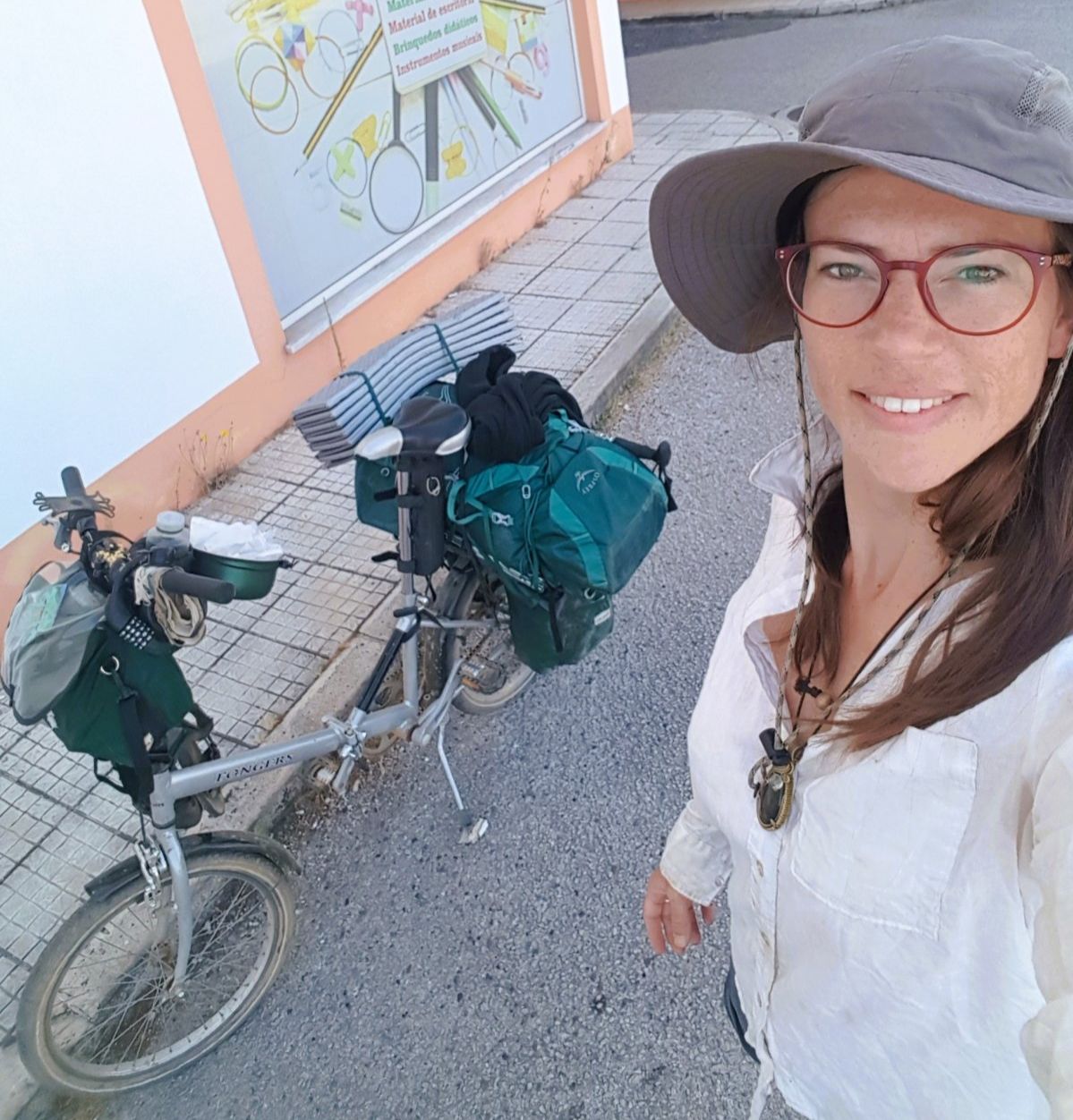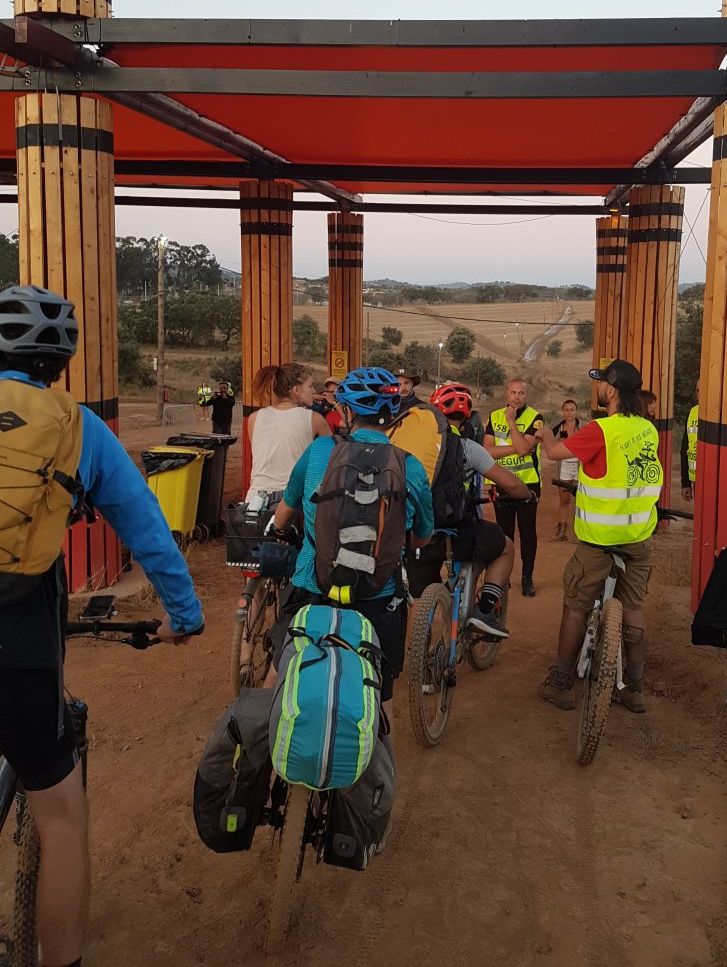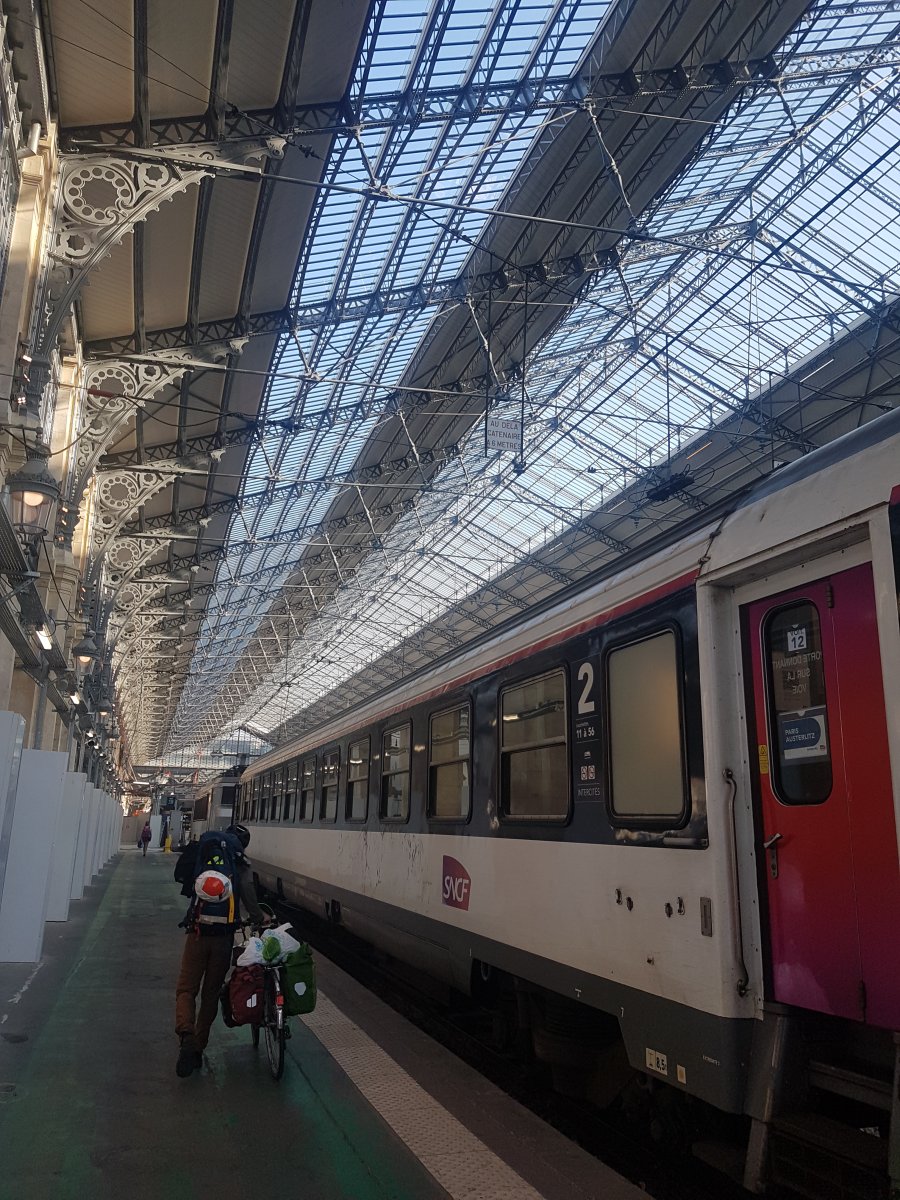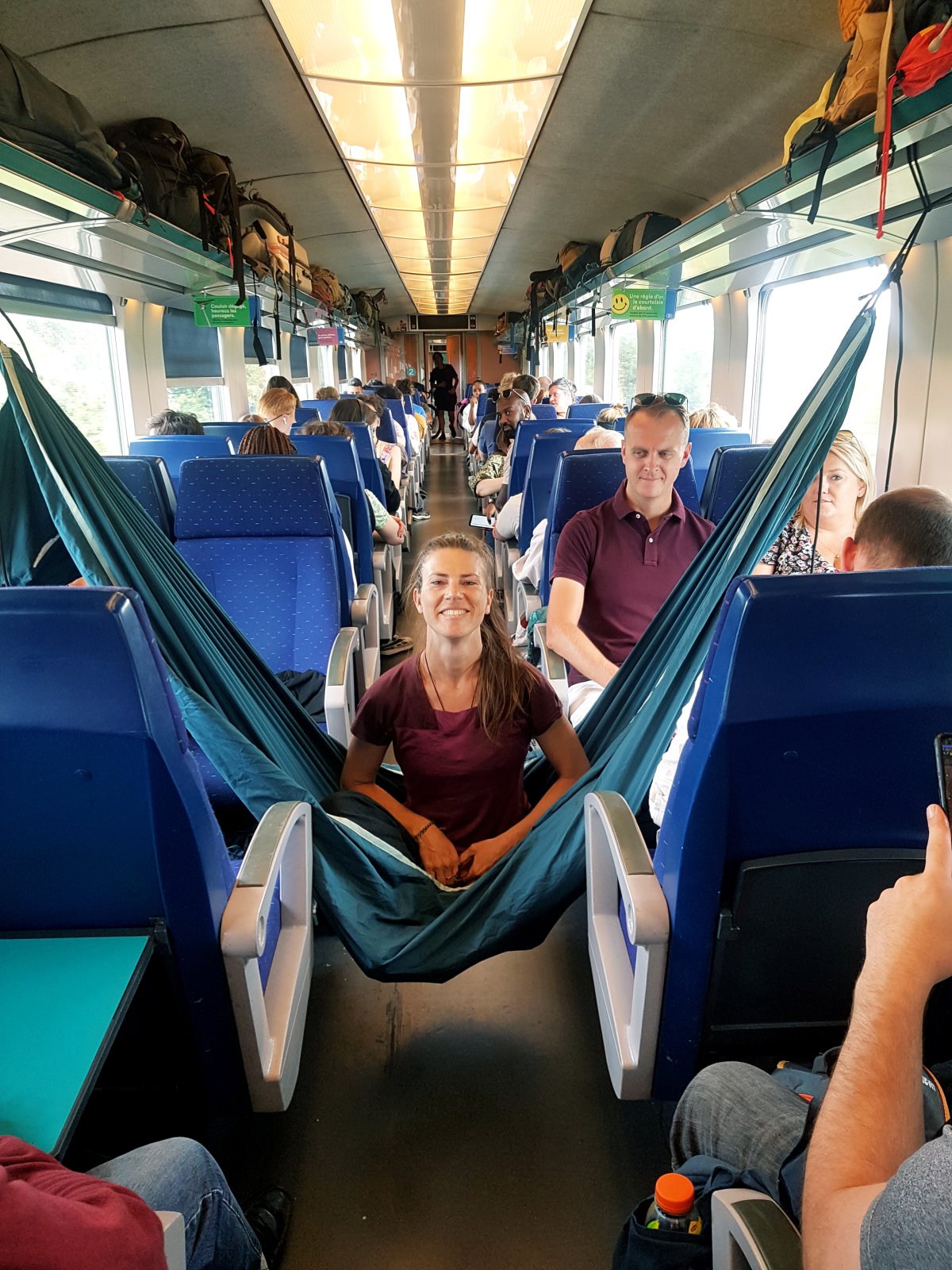Handafdruk op pedalen - Boom by Bike !
Ik fietste naar het Boom Festival in Portugal met de Boom-by-Bike-initiatief om mijn voetafdruk in te ruilen voor een handafdruk (de positieve sporen die we achterlaten). Van reizen met een vouwfiets + Interrail tot eten uit mijn eigen kom en beker: deze reis werd een gesprek in beweging over hoe festivals, reizen en gemeenschappen meer in lijn kunnen zijn met de planeet die we liefhebben.
Waarom een “handafdruk”?
In duurzaamheid focussen we vaak op het verkleinen van onze voetafdruk (uitstoot, afval, impact). Een handafdruk draait dat om: Wat draag ik actief bij? Wie nodig ik uit, inspireer of ondersteun ik om beter te doen? Voor mij was fietsen naar Boom Festival precies dat: een zichtbaar, deelbaar gebaar dat zegt: “dit kan”. Niet alleen voor de ultra-hardcore fietser, maar ook voor gewone mensen met een fiets, een treinkaartje en een beetje nieuwsgierigheid.

Wat is Boom?
Boom is een tweejaarlijks festival aan een meer in Portugal, geboren uit de psytrance-cultuur: snelle, gelaagde, hypnotiserende soundscapes die hun wortels hebben in de Goa-scene van de jaren ’90, en die draaien om vrijheid, verbinding en natuur. Naast de dansvloeren programmeert Boom ook workshops en lezingen over bewustzijn en ecologie. De organisatoren pionieren al jaren met indrukwekkende duurzame maatregelen: composttoiletten, waterzuivering met rietvelden, regeneratief landschap, veel vegetarische/vegan opties, zonne- en hybride energiesystemen, samenwerking met de naastgelegen dorpen, en reisalternatieven zoals eco-bussen, carpooling en natuurlijk Boom-by-Bike.
Boom is een tweejaarlijks festival aan een meer in Portugal, geboren uit de psytrance-cultuur: snelle, gelaagde, hypnotiserende soundscapes die hun wortels hebben in de Goa-scene van de jaren ’90, en die draaien om vrijheid, verbinding en natuur. Naast de dansvloeren programmeert Boom ook workshops en lezingen over bewustzijn en ecologie. De organisatoren pionieren al jaren met indrukwekkende duurzame maatregelen: composttoiletten, waterzuivering met rietvelden, regeneratief landschap, veel vegetarische/vegan opties, zonne- en hybride energiesystemen, samenwerking met de naastgelegen dorpen, en reisalternatieven zoals eco-bussen, carpooling en natuurlijk Boom-by-Bike.
Niet iedereen komt voor de ecologische of spirituele dimensie. Ik zag bergen verpakkingsmateriaal mee het terrein op, slecht gescheiden afval, en kapotte tenten en matrassen die achtergelaten werden. Boom produceert nog steeds véél minder afval dan commerciële festivals, maar het meest duurzame afval is natuurlijk het afval dat we niet maken. En al zijn de leerplekken op het festival rijk, slechts een klein deel van het publiek vindt zijn weg ernaartoe. Toch worden er zaadjes gepland. Dus droeg ik mijn boodschap openlijk: mijn herbruikbare kom en beker in de rijen voor de foodtrucks, mijn Boom-by-Bike finisher-T-shirt. Niet uit ego, maar uit intentie: dit normaliseren.
Waarom met de fiets en trein?
Toen mijn partner tickets wist te scoren via de resales, voelde ik meteen de vraag: Als we zo veel van de natuur houden, waarom -vliegen- we er dan naartoe? Ik had al veel lange fietstochten gedaan, dus zoiets als “Bike to Boom” begon zich al in mijn hoofd te tekenen. Toen ontdekte ik dat Boom-by-Bike al bestond: deal gesloten!
Ik combineerde een vouwfiets met een Interrail-pas. Tip: nachttreinen tellen als één reisdag vanaf vertrek, waardoor je in minder dan 24 uur van België tot de Spaanse grens (Latour-de-Carol of Perpignan) kunt reizen. De vouwfiets bleek goud waard: geen reserveringen nodig, gemakkelijk door de controles, en als je een uurtje tussen treinen hebt, kun je gewoon even de stad in.
De weg ernaartoe
Tussen Barcelona en Madrid wisselt het landschap af tussen graanvelden en droge vlaktes; Madrid tot Plasencia is de monocultuur niet anders. Op de fiets ging Extremadura open: omheinde kurkeikenweiden, irrigatiekanalen (met EU-subsidieborden) en eindeloze maïsvelden voor veevoer. Ongeveer 80% van het Spaanse graan gaat naar dierenvoer. Een herinnering dat ons voedselsysteem centraal staat binnen de planetaire grenzen. Dat is confronterend én hoopgevend: wat zo zichtbaar oorzaak is, kan ook zichtbaar worden opgelost. Ik heb zelfs een glimlachende selfie gemaakt in Monsanto (het Portugese dorp, niet het bedrijf...).
Aankomst in Boomland
Op 16 juli, bij zonsopkomst rolden we de laatste kilometers de vallei in die goud kleurde bij het ochtendlicht. Het voelde als een pelgrimstocht: zweet, endorfines, en een gedeeld “we did it” onder fietsers uit Portugal, Spanje, Zuid-Frankrijk, Duitsland, Benelux, Zwitserland en verder. Was iedereen een purist? Natuurlijk niet. Sommigen werden afgezet met de auto om een plek vrij te houden. En dat is prima: zelfs een “gedeeltelijke” rit kan iemands eerste stap zijn. Ik inspireer liever véél nabij wonende Boomers om de auto te laten staan, dan een paar heroïsche 2000-km-ritten te vieren die toch eindigen met een terugvlucht. Impact groeit door uitnodiging.
Terug fietsen en de belofte houden
En ja, practice what you preach! Dus na het festival moest ik ook weer terug met de fiets en de trein :D Toen ik Boom verliet, fietste ik langs duizenden geparkeerde auto’s, die in ellenlange files naar huis moesten vertrekken. Dat kan anders!
Hoe mijn handafdruk eruitzag
Waarom met de fiets en trein?
Toen mijn partner tickets wist te scoren via de resales, voelde ik meteen de vraag: Als we zo veel van de natuur houden, waarom -vliegen- we er dan naartoe? Ik had al veel lange fietstochten gedaan, dus zoiets als “Bike to Boom” begon zich al in mijn hoofd te tekenen. Toen ontdekte ik dat Boom-by-Bike al bestond: deal gesloten!
Ik combineerde een vouwfiets met een Interrail-pas. Tip: nachttreinen tellen als één reisdag vanaf vertrek, waardoor je in minder dan 24 uur van België tot de Spaanse grens (Latour-de-Carol of Perpignan) kunt reizen. De vouwfiets bleek goud waard: geen reserveringen nodig, gemakkelijk door de controles, en als je een uurtje tussen treinen hebt, kun je gewoon even de stad in.
De weg ernaartoe
Tussen Barcelona en Madrid wisselt het landschap af tussen graanvelden en droge vlaktes; Madrid tot Plasencia is de monocultuur niet anders. Op de fiets ging Extremadura open: omheinde kurkeikenweiden, irrigatiekanalen (met EU-subsidieborden) en eindeloze maïsvelden voor veevoer. Ongeveer 80% van het Spaanse graan gaat naar dierenvoer. Een herinnering dat ons voedselsysteem centraal staat binnen de planetaire grenzen. Dat is confronterend én hoopgevend: wat zo zichtbaar oorzaak is, kan ook zichtbaar worden opgelost. Ik heb zelfs een glimlachende selfie gemaakt in Monsanto (het Portugese dorp, niet het bedrijf...).
Aankomst in Boomland
Op 16 juli, bij zonsopkomst rolden we de laatste kilometers de vallei in die goud kleurde bij het ochtendlicht. Het voelde als een pelgrimstocht: zweet, endorfines, en een gedeeld “we did it” onder fietsers uit Portugal, Spanje, Zuid-Frankrijk, Duitsland, Benelux, Zwitserland en verder. Was iedereen een purist? Natuurlijk niet. Sommigen werden afgezet met de auto om een plek vrij te houden. En dat is prima: zelfs een “gedeeltelijke” rit kan iemands eerste stap zijn. Ik inspireer liever véél nabij wonende Boomers om de auto te laten staan, dan een paar heroïsche 2000-km-ritten te vieren die toch eindigen met een terugvlucht. Impact groeit door uitnodiging.
Terug fietsen en de belofte houden
En ja, practice what you preach! Dus na het festival moest ik ook weer terug met de fiets en de trein :D Toen ik Boom verliet, fietste ik langs duizenden geparkeerde auto’s, die in ellenlange files naar huis moesten vertrekken. Dat kan anders!
Hoe mijn handafdruk eruitzag
- Koolstofarm reizen: vouwfiets + Interrail + regionale treinen.
- Zachte advocacy: mijn Boom-by-Bike finisher-shirt om gesprekken te starten, drinken en eten uit eigen beker en kom.
- Nieuwsgierigheid onderweg: landbouw, water en landgebruik observeren; praten met locals; leren. Cafereria's zijn dorpsharten.
- Praktische tips delen zodat anderen hetzelfde kunnen proberen.
- Ga ultralicht. Voedsel én spullen vind je op elke hoek van de straat in Europa. Water gaat heel snel op.
- Vouwfiets = vrijheid. Wordt overal geaccepteerd, past in bagagerekken, maakt tussenstops tot mini-stedentrips. Een grote stevige vuilniszak is een snelle fiets-hoes én grondzeil voor de tent.
- Minder afval vanaf de start. Pak spullen uit vóór je reist; neem duurzame basics mee; leen/herstel ter plekke.



Boom by Bike initiative (English)
I cycled to Boom Festival in Portugal with the Boom-by-Bike initiative to trade footprint for handprint (his is the positive trace we leave behind). From traveling by foldable bike + Interrail to eating with my own bowl and cup, this journey became a moving conversation about how festivals, travel, and community can align with the planet we love.
Why a “handprint”?
In sustainability, we often obsess over shrinking footprints (emissions, waste, impacts). A handprint flips the lens: What do I actively contribute? Who do I nudge, inspire, or enable to do better, joyfully? For me, biking to Boom Festival was exactly that: a visible, shareable gesture that says “this is possible,” not just for the ultra-hardcore, but for everyday humans with a bike, a train ticket, and a little curiosity.
What is Boom?
Boom is a biennial, lakeside gathering in Portugal born from psytrance culture; fast, layered, hypnotic soundscapes seeded in the 1990s Goa scene and rooted in freedom, connection, and nature. Beyond dance floors, Boom curates workshops and talks on consciousness and ecology. The organizers have pioneered impressive sustainability practices: compost toilets, on-site constructed wetlands, regenerative landscaping, strong vegetarian/vegan options, solar and hybrid power systems, local collaboration with nearby villages, and transport alternatives like eco-buses, carpooling, and Boom-by-Bike.
Despite those efforts (and awards), the crowd is broadening and not everyone arrives for the ecological/spiritual dimensions. I saw mountains of packaging lugged straight into the festival, poorly separated waste, and broken tents and mattresses abandoned at the end. Boom’s waste is still far below many commercial festivals, but the most sustainable waste is the waste we never create. And while the learning spaces on site are rich, only a small slice of the crowd makes it there. Still: seeds are planted.
So I carried my message in plain sight: reusable bowl and cup in food lines, Boom-by-Bike finisher T-shirt. Not from ego, but from intention: normalize this. Make it visible. Talk about the planet’s health often, turn it into solutions, plant seeds. (If this resonates, go peek at the 89% project.)
Why by bike and train?
When my partner scored resale tickets, I felt that classic tug: If we love nature, why do we fly to dance in it? I’ve done many long rides, so ideas like “Bike to Boom” started sketching itself in my mind. Then I discovered Boom-by-Bike already exists and it was a done deal. I paired a foldable bike with an Interrail pass. Tip: overnight trains can count as a single travel day, so you can ride from Maastricht to the Spanish border (Latour-de-Carol or Perpignan) in under 24 hours. The foldable was golden: no special booking, easy through security, and if you’ve got an hour between trains, you can actually see the city.
The road in (and what it revealed)
From Barcelona to Madrid the landscape rolls between cereal fields and arid plains; Madrid to Plasencia is even more monocultural. On the bike, Extremadura opened: fenced cork-oak prairies, irrigation canals (with EU subsidy billboards), and vast corn for feed. About 80% of Spain’s cereals feed animals: a reminder that food systems sit at the heart of our planetary boundaries. It’s sobering and empowering, because what’s clearly causing the issue can also be clearly changed. There were surreal and tender moments: a Decathlon tech who dashed out with a size-13 wrench when I nearly missed a night train; a chain fixed in minutes at a Spanish garage; a string of bike shops I’d sworn didn’t exist; deserted villages with a single, packed café (blessed air-con); a moonlit descent into Plasencia; a hay-bale mattress in Vegaviana; the ghost-quiet Termas de Monfortinho and the generosity of strangers pointing me to spring water; and a smiling selfie in Monsanto (the Portuguese village, not the company...). It was all very thematic!
Golden-hour arrival at Boomland
At dawn on July 16, our mattresses exhaled phouff… phouff… phouff… and we rolled the last kilometers through eucalyptus dust, dropping into a valley gilded by sunrise. It felt like pilgrimage: sweat, endorphins, and a shared “we did it” among riders from Portugal, Spain, the south of France, Germany, The Netherlads, Swiss and further afield. Was everyone a purist? Of course not. Some cyclists were dropped early to hold spots. And that’s okay, because even a “partial” ride can be someone’s first step. I’d rather spark many nearby Boomers to leave the car than celebrate a few heroic 2,000-km slogs that end in a flight home. Impact scales through invitation.
The festival I chose
I danced myself clean. Gindajah’s Aboriginal sounds, world music at the Sacred Fire, the thundering alchemy of the main floors. Some nights I was more spent than after a full day in the saddle. The curation was loving and meticulous, from artists to teachers to makers. We could assemble our own festival: bits of this, deep dives into that, or all-night journeys under stars. And under the basslines, the handprint question pulsed: What can I do, with what I have, to make a positive impact?
Riding out and keeping the promise
Leaving Boom, I pedaled past thousands of parked cars. Another invitation formed: let’s normalize arriving by bike + train.
What my handprint looked like
Try it: practical tips
Why a “handprint”?
In sustainability, we often obsess over shrinking footprints (emissions, waste, impacts). A handprint flips the lens: What do I actively contribute? Who do I nudge, inspire, or enable to do better, joyfully? For me, biking to Boom Festival was exactly that: a visible, shareable gesture that says “this is possible,” not just for the ultra-hardcore, but for everyday humans with a bike, a train ticket, and a little curiosity.
What is Boom?
Boom is a biennial, lakeside gathering in Portugal born from psytrance culture; fast, layered, hypnotic soundscapes seeded in the 1990s Goa scene and rooted in freedom, connection, and nature. Beyond dance floors, Boom curates workshops and talks on consciousness and ecology. The organizers have pioneered impressive sustainability practices: compost toilets, on-site constructed wetlands, regenerative landscaping, strong vegetarian/vegan options, solar and hybrid power systems, local collaboration with nearby villages, and transport alternatives like eco-buses, carpooling, and Boom-by-Bike.
Despite those efforts (and awards), the crowd is broadening and not everyone arrives for the ecological/spiritual dimensions. I saw mountains of packaging lugged straight into the festival, poorly separated waste, and broken tents and mattresses abandoned at the end. Boom’s waste is still far below many commercial festivals, but the most sustainable waste is the waste we never create. And while the learning spaces on site are rich, only a small slice of the crowd makes it there. Still: seeds are planted.
So I carried my message in plain sight: reusable bowl and cup in food lines, Boom-by-Bike finisher T-shirt. Not from ego, but from intention: normalize this. Make it visible. Talk about the planet’s health often, turn it into solutions, plant seeds. (If this resonates, go peek at the 89% project.)
Why by bike and train?
When my partner scored resale tickets, I felt that classic tug: If we love nature, why do we fly to dance in it? I’ve done many long rides, so ideas like “Bike to Boom” started sketching itself in my mind. Then I discovered Boom-by-Bike already exists and it was a done deal. I paired a foldable bike with an Interrail pass. Tip: overnight trains can count as a single travel day, so you can ride from Maastricht to the Spanish border (Latour-de-Carol or Perpignan) in under 24 hours. The foldable was golden: no special booking, easy through security, and if you’ve got an hour between trains, you can actually see the city.
The road in (and what it revealed)
From Barcelona to Madrid the landscape rolls between cereal fields and arid plains; Madrid to Plasencia is even more monocultural. On the bike, Extremadura opened: fenced cork-oak prairies, irrigation canals (with EU subsidy billboards), and vast corn for feed. About 80% of Spain’s cereals feed animals: a reminder that food systems sit at the heart of our planetary boundaries. It’s sobering and empowering, because what’s clearly causing the issue can also be clearly changed. There were surreal and tender moments: a Decathlon tech who dashed out with a size-13 wrench when I nearly missed a night train; a chain fixed in minutes at a Spanish garage; a string of bike shops I’d sworn didn’t exist; deserted villages with a single, packed café (blessed air-con); a moonlit descent into Plasencia; a hay-bale mattress in Vegaviana; the ghost-quiet Termas de Monfortinho and the generosity of strangers pointing me to spring water; and a smiling selfie in Monsanto (the Portuguese village, not the company...). It was all very thematic!
Golden-hour arrival at Boomland
At dawn on July 16, our mattresses exhaled phouff… phouff… phouff… and we rolled the last kilometers through eucalyptus dust, dropping into a valley gilded by sunrise. It felt like pilgrimage: sweat, endorphins, and a shared “we did it” among riders from Portugal, Spain, the south of France, Germany, The Netherlads, Swiss and further afield. Was everyone a purist? Of course not. Some cyclists were dropped early to hold spots. And that’s okay, because even a “partial” ride can be someone’s first step. I’d rather spark many nearby Boomers to leave the car than celebrate a few heroic 2,000-km slogs that end in a flight home. Impact scales through invitation.
The festival I chose
I danced myself clean. Gindajah’s Aboriginal sounds, world music at the Sacred Fire, the thundering alchemy of the main floors. Some nights I was more spent than after a full day in the saddle. The curation was loving and meticulous, from artists to teachers to makers. We could assemble our own festival: bits of this, deep dives into that, or all-night journeys under stars. And under the basslines, the handprint question pulsed: What can I do, with what I have, to make a positive impact?
Riding out and keeping the promise
Leaving Boom, I pedaled past thousands of parked cars. Another invitation formed: let’s normalize arriving by bike + train.
What my handprint looked like
- Low-carbon travel: Foldable bike + Interrail + regional trains.
- Soft advocacy: Wore my Boom-by-Bike finisher tee to start conversations. Use your own bowl and cup and show off :D
- Curiosity on the road: Observe agriculture, water, and land use; talk with locals; learn. Cafeterias are community hearts
- Amplification: Share practical tips so others can try the same route.
Try it: practical tips
- Go ultra-light. Food is everywhere in Europe; water isn’t: carry at least 2 L.
- Foldable = freedom. Accepted on essentially all trains, fits luggage spaces, turns layovers into micro-city tours. A big trash-bag doubles as a quick bike cover/groundsheet.
- Interrail: use the app filters for reservation-free options; plan buffer time in Spain (security scanners + delays). If you can, Madrid→Perpignan direct is smoother than via Barcelona.
- Waste less from the start. Unbox gear before you travel; bring durable essentials; borrow/repair on site.
